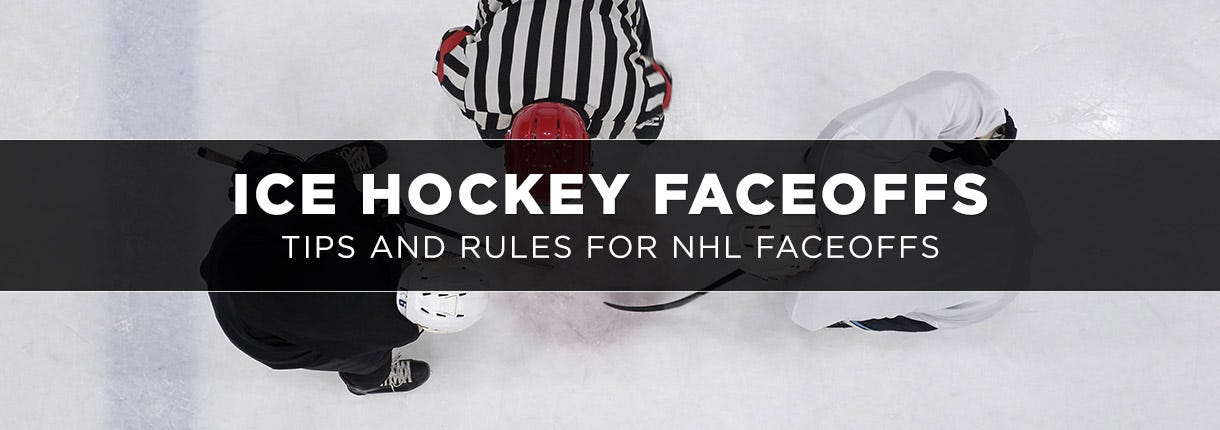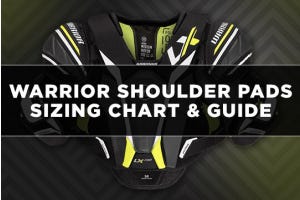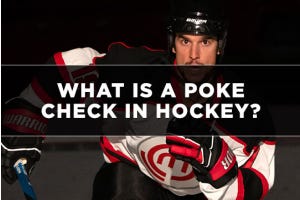Your Guide to Ice Hockey Faceoffs

Winning a hockey faceoff is always the goal for a centerman as it allows you to gain possession of the puck for your team for a potential scoring opportunity.
In this article, we’ll cover:
What is a Faceoff in Ice Hockey?
A faceoff in hockey is when two players from opposing teams line up head-to-head, and the referee drops the puck in between both players. From there, each player uses their hockey stick to try to win possession of the puck for their team. Faceoffs happen at the beginning of the game/each period or following any stoppage of play. This includes penalties, offsides, icings, goals scored, and so on. At the beginning of the period or game, or after a goal, the faceoff will always occur at center ice. When the puck touches the ice, the faceoff is officially over (and the play clock resumes).
What are the Rules for Faceoffs in Ice Hockey?
There are a few rules that players must adhere to before, during, and after a hockey faceoff. Most of the items listed below will carry over to all hockey leagues.
- Lining Up: The two players will line up at the faceoff dot, facing each other with their sticks on the white of the ice - outside of the faceoff dot.
- Teammates: The other players that aren’t involved in the faceoff must line up 15 feet away from the players facing off. For wingers, this means lining up outside of the hash marks.
- Timing: At the time of the referee stopping the play, each team has five seconds to get set up for the ensuing faceoff.
- Violations: The two players facing off cannot come in contact with each other before the puck is dropped. Also, if any player facing off attempts to get the puck before it is dropped will get tossed out of the faceoff and replaced. If the player on the offending team makes the same mistake, a two-minute bench minor penalty will be assessed.
- Post-faceoff Violation: Following the puck-drop, players must attempt to make a play on the puck rather than just going for a body check as soon as the opposing player as soon as the referee releases the puck.
Faceoff Differences by League
Faceoff procedures vary depending on the league. From the NHL, all the way down to high school leagues, each will have its own subtle differences.
NHL vs College Faceoff Rules
The biggest difference in faceoff rules between college and NHL is the use of warnings. In college, referees will not kick a player out of the faceoff for a violation but give them a warning instead. If the same player commits the violation a second time, the referee will then assess them with a minor penalty for delay of game.
NHL vs High School Faceoff Rules
The biggest difference between NHL and high school when it comes to hockey faceoffs is the strictness. Typically referees are much more lenient about the rules and procedures for younger levels of hockey. Rarely will a referee kick a youth player out of a faceoff compared to the NHL.
How to Win Hockey Faceoffs
Winning faceoffs in hockey is an essential part of the game because it helps your team gain possession of the puck and increases scoring chances. Luckily, there are a number of different tactics and skills that players can incorporate into their game to help them win more hockey faceoffs.
Have a plan
Going into a faceoff, it is crucial to have a plan for when the ref drops the puck. For example, if the faceoff is in the attacking zone, the centerman will attempt to win the faceoff back to one of his defensemen for a shot on net or to set up a play. Having set strategies during certain game situations can help set your team up for a win! Also, it is important to note the situation of the game. Is your team up with a few seconds left in the game? Is your team on the penalty kill? How you execute your faceoff strategy may vary based on what is happening in-game.
Communicate
Going hand in hand with the step above, communicating with your teammates before the faceoff happens is also essential, whether it is a set-up strategy or called on the fly. If you are in the offensive zone, the puck is typically won back to one of the defensemen to help set up the play or for a shot on net.
Timing and Reflexes
To have a better chance of winning the faceoff, a centerman needs to have great reflexes. As soon as the referee drops the puck, a good centerman will be able to bat it out of the air and to a teammate before it even hits the ice. Of course, this is very difficult and doesn’t happen often, but you always want to make sure you get your stick on the puck before your opponent does if and when it does hit the ice. A good way to practice this is to have someone mimic a referee by having them drop the puck in front of you and practice your quickness in retrieving it. You can also work on your hand-eye coordination by bouncing and catching a golf ball.
Stance
Having a solid stance when lining up for a faceoff is also essential. When the puck hits the ice, the two players facing off will almost always come in contact with each other some way or another, whether it’s their bodies or sticks. Make sure to have a strong base with your skates out wide and knees bent. Also, have your bottom hand low on your stick, almost to where the top of the blade is, so you can get great leverage when the puck hits the ice.
Strength
Another key aspect of winning hockey faceoffs is having adequate wrist and forearm strength. Oftentimes, after the puck is dropped, you will be battling for it with your sticks to gain possession. Being strong on your stick will allow you to outmuscle the other player. This can also help you lift the other players’ stick easier to help gain possession as well. Work on this by getting a hand/grip strengthener.
Ice Hockey Faceoff FAQs
Why do refs kick players out of faceoffs?
Sometimes refs in hockey will kick players out of the faceoff and replace the player with a skater on the ice from the same team. This happens when a player physically moves forward too much before the puck is dropped. Another reason a ref will kick a player out of a faceoff is if a player moves his stick to go for the puck too early (as it's dropping).
Who has to put their stick down first in a faceoff?
For faceoffs in the offensive zones, the defending teams' faceoff man will put his stick down first. For faceoffs in the neutral zone (between the blue lines), the opposing teams' faceoff man will put his stick down first.
How do they decide who wins a faceoff in hockey?
The faceoff winner in hockey is determined when a player gains full possession of the puck following the faceoff. Usually, the faceoff man will try to win the puck to one of his teammates. If there is a scrum between the two centermen, whoever comes up with the puck at the end is deemed the winner.
How many faceoff dots are there on the ice?
There are nine faceoff dots on the ice, two in each attacking zone, with five in the neutral zone (including center faceoff dot).









Login and Registration Form
or
Create an account